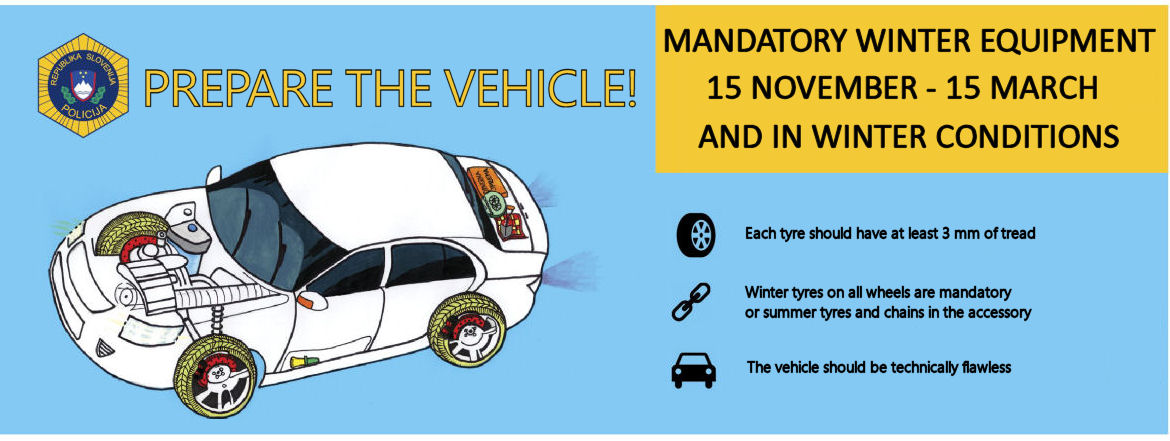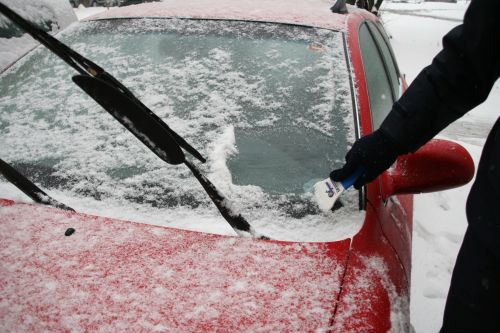Drivers, be prepared for rain, fog, snow and ice. Additional caution and greater attention are necessary in autumn and winter conditions, but still not enough for safe driving, as the vehicle must also be technically faultless and properly equipped.
Recommendations for driving in winter conditions and in winter
 Reduce the speed of your vehicle and adjust it to the conditions and road surface.
Reduce the speed of your vehicle and adjust it to the conditions and road surface.- Increase the safety distance between your vehicle and the vehicle in front of you.
- Brake lightly and gradually if necessary, by pressing the pedal several times.
- Do not change direction suddenly, as any such action can cause the vehicle to drift. The same applies to jerky starting.
- It is very important to choose the correct gear ratio, because too little power on the drive wheels can reduce the efficiency of stearing the vehicle and make necessary corrections of the driving direction impossible, while too much power can cause the drive wheels to slip and the vehicle to drift.
- Drive as steadily as possible, without heavily accelerating or slowing down.
- Pay particular attention to exposed parts of the road where black ice often occurs.
- Take into account the longer travel time, so leave home earlier than usual.
- While driving, be collected, and above all, be tolerant of other road users. In such conditions, driving culture, ethics and solidarity are especially important.
- Before driving, clean all windows well and make sure that snow, ice, water or other substances do not scatter from the vehicle.
 Check in time:
Check in time:
- tyres,
- brakes,
- lighting devices,
- winter equipment.
 Tyres
Tyres
The vehicle will be properly and well equipped if the following rules are followed:
- All 4 wheels should be equipped with winter tyres (M+S or M.S or M&S).
- Use winter tires for 4 months (at least from November 15 to March 15 of the following year).
- 3 mm is the minimum sufficient tread depth for winter tyres.
- Only winter tyres on all wheels enable successful starting and acceleration, effective braking, unchanged braking direction and safe driving through bends. Due to the special substance, even at temperatures below 7 degrees Celsius, winter tyres will be soft enough to provide adequate grip even on dry and snow-free roads.
- Only a sufficient tyre tread depth will enable good removal of water and slush from under the wheels and stability in snow and ice. When there is more snow on the road, we recommend using snow chains.
- As rubber ages as an organic substance, it loses its ability to grip the road surface optimally after four years, regardless of wear. Tyres are the only contact of our vehicle with the road, so we make sure that they are always in good condition.
- Summer tires also count as winter tires on all 4 wheels and appropriate snow chains, which must be properly installed on the drive wheels in winter conditions.
Brakes and brake fluid
Perfect functioning of the brakes is essential for safe driving, so check the brake fluid level regularly. If it has dropped slightly, it may be due to brake lining wear, if it has dropped sharply, take the vehicle to a mechanic immediately. Change the brake fluid at least every two years.
 Lights even during the day!
Lights even during the day!
The use of lights during the day is mandatory in Slovenia when driving a motor vehicle, just like in many European countries. Check repeatedly whether all devices for lighting the road, marking the vehicle and giving light signals are really working on the car.
Other winter equipment
Preparing a motor vehicle for winter should also include an inspection of other vehicle devices and equipment. In addition to tyres, brakes, steering mechanism and lights, there are several other devices that the vehicle user must periodically and carefully check before winter:
- battery - cable connections must be inspected, cleaned and lubricated, and the state of the electrolyte in the cells must be checked;
- cooling system - the density and level of the coolant must be checked;
- air intake system in the vehicle - it is recommended to check whether there are foreign objects in the system (garbage or dried leaves);
- oil in the engine - the oil level must always be between the two marks (max - min) on the dipstick;
- windscreen wetting system - it is necessary to check the amount of water in the container and add a sufficient amount of antifreeze to it;
- wiper blades - they must be checked for wear and replaced if necessary;
- v-belt - the condition and tension of the belt which ensures the rotation of the alternator, coolant pump and other devices must be checked;
- fuel supply system - for vehicles with a diesel engine, it is recommended to check and clean the fuel filter if necessary;
- door seals - if you occasionally lubricate them with glycerin, the door will not freeze on cold days despite being wet;
- locks on doors and boot lid - an occasional spray of WD 40 or similar penetrating anti-corrosive will prevent the lock from freezing.
 In a car ready for winter driving belongs a small broom and a scraper for cleaning the windows. Also check the wipers, as the rubber may be torn or otherwise damaged.
In a car ready for winter driving belongs a small broom and a scraper for cleaning the windows. Also check the wipers, as the rubber may be torn or otherwise damaged.
There should be enough liquid in the windshield washer fluid container that will not freeze in the cold.
Devices for defrosting and drying the windscreen as well as devices for heating and ventilation must ensure normal visibility through the glass.
Before a long drive, check whether you have enough fuel in the tank. Snow can also surprise the winter service and it happens that the vehicle with helpless passengers stops on the road, so a blanket in the vehicle will not be superfluous.
Related content
Winter in road traffic - provisions on winter equipment
Traffic safety

